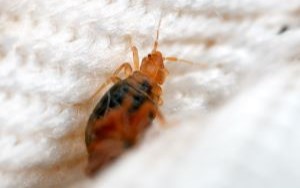
Whether you are in a hospital, doctor’s office, retirement community, or some other form of healthcare facility, you expect things to be clean – and you definitely don’t expect to find bed bugs.
Hospitals and doctor offices, in particular, are expected to have a sterile environment where beds, patient areas, medical equipment, and other important components of patient care are kept clean and free from insects. With that said, did you know that finding bed bugs in hospitals and healthcare facilities is actually a common occurrence? As your local pest control experts in Wisconsin, here are a few things we think you should know.
Need a bed bug estimate?
Can You Get Bed Bugs from Hospitals and Doctors Offices?
Yes, like any other establishment, healthcare facilities are not immune to bed bug infestations and can serve as common sources of transmission.
Why Are Healthcare Facilities a Bed Bug Risk?
Hospitals, hospices, elder care facilities, and group homes are at a higher risk of bed bug infestations because they have a lot of people coming and going, many personal belongings, and numerous sleeping areas. These conditions create an environment where bed bugs can easily spread and affect staff, visitors, and patients.
How to Prevent Bringing Bed Bugs Home from a Medical Facility
To prevent bringing bed bugs home from a medical facility, follow these simple steps:
- Inspect Belongings: Before leaving the facility, check your personal items for bed bugs.
- Use Sealed Bags: Keep your stuff in sealed plastic bags at the facility.
- Wash and Dry Clothes: When you get home, wash and dry your clothes on high heat.
- Inspect Luggage: Examine your luggage and store it in a sealed bag after your visit.
- Avoid Beds and Sofas: Don’t place items on beds or upholstered furniture at the facility.
- Be Aware & Notify the Facility: Watch for unusual bites and tell the facility if you suspect bed bugs.
- Home Inspections: Regularly check your home for bed bugs, especially after healthcare visits.
- Pest Control Services: Consider hiring a pest control company for regular bed bug inspections and preventative treatments. This will ensure your home stays protected year-round.
These steps make it easier to protect your home from potential bed bug infestations after a visit to a medical facility. Early action is key to prevention.
Bed Bug Protocol for Hospitals and Healthcare Facilities
Implementing a bed bug protocol in hospitals and healthcare facilities is crucial to prevent and address infestations. Here’s a basic protocol that can be adapted and expanded to meet the specific needs of your facility:
- Education and Training: Train staff to recognize the signs of bed bugs, including bites, physical symptoms, and visual identification of bed bugs. Provide information and guidelines to staff about reporting suspected bed bug incidents.
- Regular Inspections: Conduct routine inspections of patient rooms, waiting areas, and common spaces to detect early signs of bed bugs. Inspect bedding, furniture, and patient belongings for any evidence of bed bug activity.
- Patient and Visitor Education: Provide educational materials to patients and visitors about bed bugs, including how to recognize them and what to do if they suspect an infestation. Encourage patients to report any bites or skin irritations to the healthcare staff.
- Response Plan: Develop a clear and detailed response plan for addressing suspected or confirmed bed bug infestations. Isolate affected areas or rooms to prevent the spread of bed bugs.
- Professional Pest Control: Establish a partnership with a licensed pest control provider experienced in bed bug management.
- Patient Belongings: Implement guidelines for the handling of patient belongings, including proper storage and inspection. Provide patients with options for secure storage of personal items during their stay.
- Laundry and Linen Care: Follow industry standards for laundering and handling bedding, linens, and textiles to eliminate bed bugs.
- Communication and Documentation: Maintain records of bed bug incidents, inspections, and treatments. Communicate transparently with patients, staff, and visitors about any bed bug issues.
- Preventive Measures: Implement measures to reduce the risk of bed bug introduction, such as routine cleaning, monitoring, and the use of bed bug-proof encasements on mattresses and box springs.
How to Get Rid of Bed Bugs in Hospitals
Getting rid of bed bugs in hospitals is a challenging task due to the sensitive nature of healthcare environments. However, it’s essential to address the problem promptly to ensure the safety and well-being of patients, staff, and visitors. The best way to do that is to work closely with a reputable pest control provider experienced in healthcare settings and adhere to all relevant regulations and guidelines. The eradication of bed bugs in hospitals requires a careful and systematic approach to ensure the safety and comfort of patients and staff.
Bed Bug Control Services in Wisconsin
When it comes to tackling bed bug control, especially within healthcare settings, it’s crucial to have a trusted partner who understands the unique challenges involved. At Batzner Pest Control, we pride ourselves on our proven expertise in effectively managing bed bug infestations in healthcare facilities.
Our dedicated professionals use safe, reliable methods, implement stringent containment measures, and provide ongoing education to ensure a comprehensive and long-lasting solution. We strongly encourage both individuals and healthcare institutions to consider Batzner Pest Control as their reliable ally in the battle against bed bugs in New Berlin WI and surrounding areas.
Contact us today for a free, no-obligation quote!
Bed Bugs in Hospitals and Healthcare Facilities in Wisconsin
Serving Wisconsin
New Berlin | Oshkosh | Milwaukee | Kenosha | Madison | Racine | Appleton | Fond du Lac | Sheboygan
Cedarburg | Green Bay | La Crosse | Eau Claire | Baraboo | Wisconsin Dells | Wisconsin Rapids | Mauston | Viroqua | Chippewa Falls
Home » Bed Bug Services and Treatments » Bed Bugs in Hospitals and Healthcare Facilities

